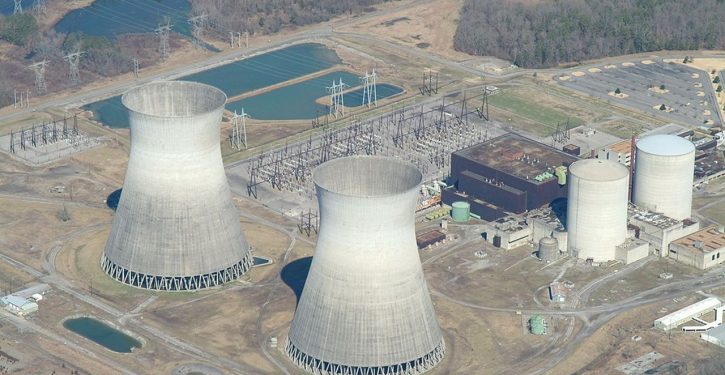
South Africa is experiencing blackouts, and experts say parts of America may experience blackouts this summer for similar reasons. “South Africans are struggling in the dark to cope with increased power cuts that have hit households and businesses across the country,” reports the Associated Press:
The rolling power cuts have been experienced for years but this week the country’s state-owned power utility Eskom extended them so that some residents and businesses have gone without power for more than 9 hours a day.
A strike by Eskom workers added to the utility’s woes including breakdowns of its aging coal-fired power plants, insufficient generation capacity and corruption…The prolonged power cuts are hitting South Africans in the winter months of the Southern Hemisphere when many households rely on electricity for heat, light and cooking.
Small and large businesses have had to close down for prolonged periods or spend large amounts for diesel fuel to operate generators. Anger and frustration is widespread among business owners and customers at the power cuts, which Eskom calls load shedding.
The power blackouts are here to stay, say experts, who warn it will take years to substantially increase South Africa’s capacity to generate power. South Africa mines coal and relies heavily on coal-fired plants, which causes noticeable air pollution. The country is looking to increase power production from solar and other renewable sources.
As Jazz Shaw notes,
South Africa has always relied primarily on coal-fired power plants because the country sits on rich deposits of coal. But their leaders have followed the same trends we’re seeing in other developed nations around the world, growing “squeamish” about using coal and looking to set up more solar and wind energy farms. Maintenance of some of the coal plants has been neglected because they anticipated the eventual closure of those facilities. Some of them have gone offline.
Meanwhile, demand for electricity has only increased. When people attempt to draw more electricity off the grid than it’s capable of producing, bad things happen. Hence the planned, rolling blackouts by Eskom. They can’t simply wave a magic wand and make more energy appear.
Blackouts may soon affect the United States, too, as it also retires older coal and nuclear power plants. As we noted earlier, experts say blackouts are coming this summer, probably to at least a dozen states. News Nation reports:
Blackouts could plague a number of states in the U.S. this summer, regulators warn, as a combination of drought, heat, potential cyber attacks, geopolitical conflicts and supply chain problems could disrupt the power supply, according to a grim new report…large swathes of the U.S. and parts of Canada are at an elevated or high risk of energy shortfalls during the summer’s hottest months.
The Midwest is at especially high risk due to the retirement of older plants, which has caused a 2.3% decrease in capacity from last summer…In the Southwest, plummeting river levels may cripple hydropower production….in Texas drought-related heat events could cause extreme energy demand.
A NERC map shows all states in the western half of the continental U.S., including North Dakota, South Dakota, Nebraska, Kansas, Oklahoma and Texas are at least under elevated risk of energy shortfalls, with parts of the northeastern-most states under high risk…Arkansas, Louisiana, Michigan, Wisconsin, Iowa, Minnesota, Iowa, Illinois and Indiana are either entirely or partly at high risk.
“Persistent, extreme drought … create extra stresses on electricity supply and demand,” said Mark Olson…“Grid operators in affected areas will need all available tools to keep the system in balance this summer.”
In California, where all 58 counties are under a drought emergency proclamation, officials are already warning residents that more than one million addresses may go dark this summer due to an energy shortfall.
The drought hampers the state’s ability to harvest energy from hydroelectric dams – in 2021, for example, the state was forced to shut off hydropower generation at the Oroville Dam in Northern California for the first time ever.
Wildfires and forecasted hotter-than-normal temperatures are also projected to further strain the energy supply….in Texas… a combination of factors such as extreme demand, low wind and outages at production plants could lead to blackouts.
As Hot Air notes, “When demand for electricity exceeds supply, the utility companies will either have to begin a series of rolling blackouts in all of the affected states or the grid will suffer crippling damage and be down for months.”
This could result in hundreds or even thousands of deaths, as energy runs short due to closures of power plants in the name of fighting climate change:
When the power grid in Texas failed in February of 2021, more than 200 people died, nearly all of them from hypothermia….this won’t just impact California and Texas. A minimum of 14 states will be hit by this in a rolling sequence. As water levels fall, you eventually reach the point where your ability to produce hydroelectric electricity from dams diminishes.
Meanwhile, there are 40 coal-fired power plants scheduled to be taken offline in the name of fighting climate change. No replacement sources for all of that juice have been proposed, to say nothing of having them come online….We need to streamline the regulatory hurdles in the nuclear power approval process to bring more of the next-generation small module reactors (SMRs) online quickly wherever it is practical to do so.
Nuclear power plants do not cause climate change. Nuclear plants produce no air pollution or greenhouse gas emissions (they emit only harmless steam into the air). France and Sweden replaced most of their fossil-fueled electricity with nuclear power, and as a result, ended up emitting less than a tenth of the world average of carbon dioxide per kilowatt-hour. Climate experts and the International Energy Agency note that limiting global warming to 2 degrees Celsius would require doubling nuclear power by 2050.
Yet, U.S. authorities continue to close nuclear power plants in places like New York, where the state’s governor killed the Indian Point nuclear plant, which provided “highly reliable, low-cost and emissions-free” energy for many state residents, according to the New York Post
The result of these closures is higher greenhouse gas emissions and less available energy. Climate Wire reports:
New York passed a law in 2019 requiring the state to eliminate carbon dioxide emissions from power plants by 2040. But over the last two years, the exact opposite has happened: CO2 from power plants has climbed nearly 15 percent, according to EPA data. New York’s experience is hardly unique. In neighboring New England, where six states are united by a single electricity market, power emissions are up 12 percent over the last two years. And in Pennsylvania, emissions from electricity generation have grown 3 percent. The rise in emissions follows the closure of three nuclear facilities in Massachusetts, New York and Pennsylvania since 2019. While all three states have expanded their renewable energy generation, natural gas has largely filled the void left by shuttered nuclear facilities, prompting emissions to rise.
Unlike wind farms, nuclear power plants don’t kill birds. The biggest utility that generates wind power recently pleaded guilty to federal crimes for killing 150 eagles.
Yet it usually takes at least a decade to get regulatory approval for a new nuclear plant. The regulatory process is highly inefficient and massively increases the cost of nuclear plants. There is widespread opposition to building new nuclear plants, and more are closing than being constructed.
Yet “nuclear power is the safest form of energy we have, if you consider deaths per megawatt of energy produced,” notes Yale University’s Steven Novella. “Wind turbines, surprisingly, kill more people than nuclear plants,” notes Michael Shellenberger, who was named a “Hero of the Environment” by Time magazine. And “solar panels require 17 times more materials in the form of cement, glass, concrete, and steel than do nuclear plants, and create over 200 times more waste,” such as “dust from toxic heavy metals including lead, cadmium, and chromium.”
U.S. nuclear energy production peaked in 2018 at 20% of America’s power supply, due to rising efficiency, even though some nuclear power plants had already been closed.



